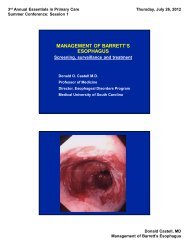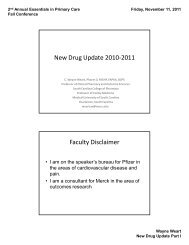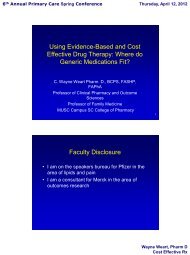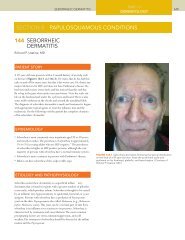163 BASAL CELL CARCINOMA SECTION 12 SKIN CANCER
163 BASAL CELL CARCINOMA SECTION 12 SKIN CANCER
163 BASAL CELL CARCINOMA SECTION 12 SKIN CANCER
You also want an ePaper? Increase the reach of your titles
YUMPU automatically turns print PDFs into web optimized ePapers that Google loves.
MHBD<strong>12</strong>5-<strong>163</strong>[704-711].qxd 8/15/08 11:39 AM Page 704PART 13704 CHAPTER <strong>163</strong>DERMATOLOGY<strong>SECTION</strong> <strong>12</strong><strong>SKIN</strong> <strong>CANCER</strong><strong>163</strong> <strong>BASAL</strong> <strong>CELL</strong><strong>CARCINOMA</strong>Richard P. Usatine, MDPATIENT STORYA 52-year-old woman presented to the office with a “mole” that hadbeen increasing in size over the last year (Figure <strong>163</strong>-1).This “mole”had been on her face for at least 5 years.The differential diagnosis ofthis lesion was a nodular basal cell carcinoma (BCC) versus an intradermalnevus.A shave biopsy confi med it was a nodular BCC and thelesion was excised with an elliptical excision.EPIDEMIOLOGY• BCC is the most common skin cancer; 80% of skin cancers areBCCs.• Incidence of these cancers increases with age, related to cumulativesun exposure.• Nodular BCCs—most common type (Figures <strong>163</strong>-1 to <strong>163</strong>-4).• Superficial BCCs—next most common type Figure <strong>163</strong>-5).• Sclerosing BCCs—least common type (Figures <strong>163</strong>-6 and <strong>163</strong>-7).FIGURE <strong>163</strong>-1 Pearly nodular BCC on the face of a 52-year-oldwoman present for 5 years. (Courtesy of Richard P. Usatine, MD.)ETIOLOGY AND PATHOPHYSIOLOGY• Most important risk factors are sun exposure, family history, andskin type.• BCCs spread locally and rarely metastasize.• Basal cell nevus syndrome is a rare autosomal dominant conditionin which affected individuals have multiple nevoid BCCs (Figure<strong>163</strong>-8).DIAGNOSISCLINICAL FEATURESClinical features of the three types of BCCs:Nodular BCC• Raised pearly white, smooth translucent surface withtelangiectasias.• Smooth surface with loss of the normal pore pattern (Figures<strong>163</strong>-1 to <strong>163</strong>-4).• May be pigmented (Figures <strong>163</strong>-9 to <strong>163</strong>-11).FIGURE <strong>163</strong>-2 Nodular BCC on the nasal ala of a 82-year-old woman.The nose is a very common location for a BCC. (Courtesy of Richard P.Usatine, MD.)
MHBD<strong>12</strong>5-<strong>163</strong>[704-711].qxd 8/15/08 11:39 AM Page 705<strong>BASAL</strong> <strong>CELL</strong> <strong>CARCINOMA</strong>PART 13DERMATOLOGY705• May ulcerate (Figures <strong>163</strong>-<strong>12</strong> to <strong>163</strong>-15) and can leave a bloodycrust.Superficial BC• Red or pink scaling plaques with a thready border (slightly raisedand pearly) (Figure <strong>163</strong>-5).• Found more on the trunk and upper extremities than the face.Sclerosing BCC• Ivory or colorless, fl t or atrophic, indurated, may resemble scars,are easily overlooked (Figures <strong>163</strong>-6 and <strong>163</strong>-7).• Called morpheaform because of their resemblance to localized scleroderma(morphea).• Called infiltr ting BCCs because the border is not well demarcatedand the tumor can spread out way beyond what is visible (Figure<strong>163</strong>-16A to C).• These BCCs are the most dangerous and have the worst prognosis.TYPICAL DISTRIBUTIONNinety percent appear on face, ears, and head with some found on thetrunk and upper extremities (especially the superficial type)DERMOSCOPYDermoscopic characteristics of BCCs (Figure <strong>163</strong>-17A to B)include (see Dermoscopy Appendix):• Large gray-blue ovoid nests.• Multiple gray-blue globules.• Leafli e areas- that look like maple leaves.• Spoke wheel areas.• Arborizing “tree-like” telangiectasia.• Ulceration.• Shiny white areas/stellate streaks.BIOPSY• A shave biopsy is adequate to diagnose a nodular BCC or a thick superficialBC .• A scoop shave or punch biopsy is preferred for a sclerosing BCC ora very fl t superficial BC .FIGURE <strong>163</strong>-3 Nodular BCC on the lower eyelid. Patient referred forMohs surgery. (Courtesy of Richard P. Usatine, MD.)DIFFERENTIAL DIAGNOSISNodular BCC• Intradermal (dermal) nevi often have features in common with aBCC when present on the face.These features include being pearlyand having multiple telangiectasias as seen in Figure <strong>163</strong>-18.Theirstable size and symmetry may be helpful in distinguishing themfrom a nodular BCC.A simple shave biopsy is diagnostic andproduces a good cosmetic result.A large excisional biopsy with4-mm margins for a BCC may be cosmetically deforming on theface if it turns out that the lesion was nothing more than a benignintradermal nevus. It is remarkable how similar Figure <strong>163</strong>-18FIGURE <strong>163</strong>-4 Large nodular BCC with an annular appearance on theface of a homeless woman. (Courtesy of Richard P. Usatine, MD.)
MHBD<strong>12</strong>5-<strong>163</strong>[704-711].qxd 8/15/08 11:39 AM Page 706PART 13706 CHAPTER <strong>163</strong>DERMATOLOGYappears to <strong>163</strong>-1 (both biopsies proven to be as labeled) (see Chapter155, Benign Nevi).• Sebaceous hyperplasia is a benign condition commonly seen on theface in older adults and usually occurs with more than one lesionpresent (Figure <strong>163</strong>-19).This benign overgrowth of the sebaceousglands produces small papules that have a doughnut shape with frequenttelangiectasias (see Chapter 152, Sebaceous Hyperplasia).• Fibrous papule of the face is a benign condition with small papulesthat can be fi m and pearly.• Trichoepithelioma/trichoblastoma are benign tumors on the facethat can appear around the nose.They may be pearly but usually donot have telangiectasias.These are best diagnosed with a shavebiopsy.• Keratoacanthoma is a type of squamous cell carcinoma that israised, nodular and may be pearly with telangiectasias.A centralkeratin filled cr ter may help to distinguish this from a BCC (seeChapter 160, Keratoacanthoma).Superficial BC• Actinic keratoses are precancers that are fl t, pink and scaly.Theylack the pearly and thready border of the superficial BCC (seChapter 159,Actinic Keratosis/Bowen’s Disease).• Bowen’s disease is an SCC in situ that appears like a larger thickeractinic keratosis with more distinct well-demarcated borders. Italso lacks the pearly and thready border of the superficial BCC (seChapter 159,Actinic Keratosis/Bowen’s Disease).• Nummular eczema can usually be distinguished by its multiplecoin-like shapes, transient nature, and rapid response to topicalsteroids.These lesions are pruritic and most patients will have othersigns and symptoms of atopic disease (see Chapter 139,AtopicDermatitis).FIGURE <strong>163</strong>-5 Superficial BCC on the back of a 45-year-old man whoenjoys running in the California sun without his shirt. Note the diffusescaling, thready border (slightly raised and pearly), and spotty hyperpigmentation.(Courtesy of Richard P. Usatine, MD.)Sclerosing BCC• Scars may look like a sclerosing BCC.Ask about previous surgeriesor trauma to the area. If the so-called scar is fl t, shiny, and enlarging,a biopsy still may be needed to rule out a sclerosing BCC.MANAGEMENT• Mohs micrographic surgery (three studies, n 2,660) is the goldstandard but is not needed for all BCCs. Recurrence rate 1 is 0.8%to 1.1%. Mohs micrographic surgery is the removal of tumor byscalpel in sequential horizontal layers in which each tissue sample isfrozen, stained, and microscopically examined.This is repeated untilall the margins are clear (Figure <strong>163</strong>-16A to C).This is thetreatment of choice for BCCs with poorly defined mar ins involvingareas of cosmetic or functional importance such as nose oreyelids. 1 SOR• Surgical excision (three studies, n 1303): Recurrence rate 1 was2% to 8%. Mean cumulative 5-year rate 1 (all 3 studies) was 5.3%.Recommended margins are 4 to 5 mm. 1 SOR• Cryosurgery (Four studies, n 796): Recurrence rate was 3.0% to4.3%. Cumulative 5-year rate (three studies) ranged from 0% to16.5%. 1 SOR Recommended freeze times are 30 to 60 secondsFIGURE <strong>163</strong>-6 Sclerosing BCC on the forehead of a man resemblinga scar. Note the white color with shiny atrophic skin. (Courtesy of SkinCancer Foundation.)
MHBD<strong>12</strong>5-<strong>163</strong>[704-711].qxd 8/15/08 11:39 AM Page 707<strong>BASAL</strong> <strong>CELL</strong> <strong>CARCINOMA</strong>PART 13DERMATOLOGY707with 5 mm halo.This can be divided up into two 30 second freezeswith a thaw in between. Some patients might prefer local anestheticif the freezing is too painful. SOR• Curettage and desiccation (six studies, n 42<strong>12</strong>): Recurrence rateranged from 4.3% to 18.1%; cumulative 5-year rate ranged from5.7% to 18.8%. 1 Three cycles of curettage and desiccation can producehigher cure rates than one cycle. 1 SOR• Imiquimod is FDA approved for the treatment of superficial BCCless than 2 cm in diameter. 2 SOR Confi m diagnosis with biopsyand use when surgical methods are contraindicated. 2PATIENT EDUCATIONWhile most of the sun damage has been done, patients should stillpractice skin cancer prevention by sun-protective behaviors such asavoiding peak sun, covering up and using sunscreen.FOLLOW-UPPatients should be seen at least yearly after the diagnosis andtreatment of a BCC.The 3-year risk of BCC recurrence after having asingle BCC is 44%. 3PATIENT RESOURCESThe Skin Cancer Foundation has an excellent web site with photosand patient information—http://www.skincancer.org/basal/index.php.FIGURE <strong>163</strong>-7 Advanced sclerosing BCC on the cheek of a man,causing ectropion (the eyelid is being pulled down by the sclerotic skinchanges). (With permission from Usatine RP, Moy RL, Tobinick EL,Siegel DM. Skin Surgery: A Practical Guide. 1998, St. Louis: Mosby. )PROVIDER RESOURCEBritish Journal of Dermatology (1999;141:415–423) for specifiguidelines for managing BCC—http://www.bad.org.uk/healthcare/guidelines/Basal_Cell_Carcinoma.pdf.FIGURE <strong>163</strong>-8 Basal cell nevus syndrome with multiple nevoid BCCson the face and neck of a young woman. This is a rare autosomal dominantcondition. (Courtesy of the University of Texas Health SciencesCenter, Division of Dermatology.)
MHBD<strong>12</strong>5-<strong>163</strong>[704-711].qxd 8/15/08 11:39 AM Page 708PART 13708 CHAPTER <strong>163</strong>DERMATOLOGYFIGURE <strong>163</strong>-9 Large pigmented nodular BCC on the face with ulceration.(With permission from Usatine RP, Moy RL, Tobinick EL, SiegelDM. Skin Surgery: A Practical Guide. 1998, St. Louis: Mosby. )FIGURE <strong>163</strong>-11 Darkly pigmented BCC with pearly borders and someulceration in a 73-year-old Hispanic woman. A biopsy was performedto rule out melanoma before this was excised. (Courtesy of Richard P.Usatine, MD.)FIGURE <strong>163</strong>-10 Darkly pigmented large BCC with raised borders andsome ulceration in a 53-year-old Hispanic man. A biopsy wasperformed to rule out melanoma before this was excised. (Courtesy ofRichard P. Usatine, MD.)FIGURE <strong>163</strong>-<strong>12</strong> Ulcerated BCC on the cheek of a black man. (Withpermisson from Usatine RP, Moy RL, Tobinick EL, Siegel DM. SkinSurgery: A Practical Guide. 1998, St. Louis: Mosby.)
MHBD<strong>12</strong>5-<strong>163</strong>[704-711].qxd 8/15/08 11:39 AM Page 709<strong>BASAL</strong> <strong>CELL</strong> <strong>CARCINOMA</strong>PART 13DERMATOLOGY709FIGURE <strong>163</strong>-13 BCC in the nasal alar groove. There is a high riskof recurrence at this site so Mohs surgery is indicated for removal.(Courtesy of Richard P. Usatine, MD.)FIGURE <strong>163</strong>-15 Very large ulcerating BCC on the neck of a 65-yearoldwhite man, which has been growing there for 6 years. It wasexcised in the operating room with a large flap from his chest used toclose the big defect. (Courtesy of Richard P. Usatine, MD.)FIGURE <strong>163</strong>-14 Large advanced BCC with ulcerations and bloodycrusting infiltrating the upper lip. The patient was referred for Mohssurgery. (Courtesy of Richard P. Usatine, MD.)
MHBD<strong>12</strong>5-<strong>163</strong>[704-711].qxd 8/15/08 11:40 AM Page 710PART 13710 CHAPTER <strong>163</strong>DERMATOLOGYAABBFIGURE <strong>163</strong>-17 (A) Large nodular BCC on the cheek of a 52-year-oldman. There is a loss of normal pore pattern, pearly appearance, telangiectasias,and some areas of dark pigmentation. (B) Dermoscopy of theprevious nodular BCC. There are visible arborizing “tree-like” telangiectasias,ulcerations, shiny white areas and blue-grey globules all consistentwith a BCC. (Courtesy of Richard P. Usatine, MD.)CFIGURE <strong>163</strong>-16 (A) Sclerosing BCC in an elderly man. The size of theBCC did not appear large by clinical examination. (B) Mohs surgery of thesame sclerosing BCC. This took four shave excisions to get clean margins.Usual 4- to 5-mm margins with an elliptical excision would not have removedthe full tumor. (C) Repair by Mohs surgery to close the large defect.The cure rate should be close to 99%. (Courtesy of Ryan O’Quinn, MD.)FIGURE <strong>163</strong>-18 Pearly dome-shaped intradermal nevus near the nosewith telangiectasias closely resembling a BCC. A shave biopsy provedthat this was an intradermal nevus. (Courtesy of Richard P. Usatine,MD.)
MHBD<strong>12</strong>5-<strong>163</strong>[704-711].qxd 8/15/08 11:40 AM Page 711<strong>BASAL</strong> <strong>CELL</strong> <strong>CARCINOMA</strong>PART 13DERMATOLOGY711REFERENCES1.Thissen MR, Neumann MH, Schouten LJ.A systematic review oftreatment modalities for primary basal cell carcinomas. ArchDermatol. 1999;135(10):1177–1183.2. Geisse J, Caro I, Lindholm J, Golitz L, Stampone P, Owens M.Imiquimod 5% cream for the treatment of superficial basal celcarcinoma: Results from two phase III, randomized, vehiclecontrolledstudies. J Am Acad Dermatol. 2004;50(5):722–733.3. Marcil I, Stern RS. Risk of developing a subsequent nonmelanomaskin cancer in patients with a history of nonmelanoma skin cancer:A critical review of the literature and meta-analysis. Arch Dermatol.2000;136(<strong>12</strong>):1524–1530.FIGURE <strong>163</strong>-19 Extensive sebaceous hyperplasia on the cheek of a52-year-old woman. Largest one has visible telangiectasias and couldbe mistaken for a BCC. (Courtesy of Richard P. Usatine, MD.)









